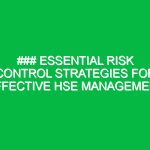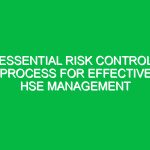Welcome and Purpose of the Toolbox Talk
Good morning, team! Today, we’re gathering for a crucial toolbox talk focused on enhancing our understanding of Motor Vehicle Safety. As we prepare to start our workday, it’s important to take a moment to discuss how we can ensure not only our own Safety but also the safety of our colleagues and the public while operating vehicles. Motor vehicle incidents can lead to serious injuries, fatalities, and significant property damage. By focusing on safety today, we aim to create a safer work Environment for everyone.
Understanding Motor Vehicle Safety in the HSE Context
Motor Vehicle Safety refers to the practices and measures taken to prevent accidents and injuries while operating vehicles, particularly in a work setting. This encompasses everything from vehicle Maintenance to safe driving behaviors. Within the Health, Safety, and Environment (HSE) framework, adhering to Motor Vehicle Safety Guidelines is essential for minimizing risks and ensuring compliance with safety Regulations.
The Importance of Motor Vehicle Safety
Why is Motor Vehicle Safety so critical? Statistics show that road traffic accidents are one of the leading causes of workplace fatalities. According to the National Safety Council, motor vehicle crashes result in thousands of injuries and deaths each year. A significant portion of these incidents occurs during work-related travel, making our commitment to safety paramount.
Incorporating effective Motor Vehicle Safety practices not only protects individuals but also helps companies avoid legal liabilities, reduce insurance costs, and maintain a positive reputation. Remember, safety is a shared responsibility, and each of us plays a vital role in upholding these Standards.
Identifying Potential Hazards
Before we dive into Best Practices, let’s talk about some potential Hazards associated with motor vehicle operations:
- Distracted Driving: This includes texting, using a phone, or engaging in other activities while driving.
- Fatigue: Long hours on the road can lead to drowsiness, significantly increasing the risk of accidents.
- Weather Conditions: Rain, snow, fog, and ice can severely impact driving conditions.
- Vehicle Maintenance: Poorly maintained vehicles can lead to breakdowns or accidents due to mechanical failure.
- Speeding: Driving above the speed limit reduces reaction time and increases the severity of accidents.
Being aware of these hazards is the first step in mitigating risks and ensuring your safety while driving.
Best Practices for Motor Vehicle Safety
Now that we’ve identified potential hazards, let’s discuss some actionable Best Practices that you can implement:
1. Pre-Trip Inspections
Before you hit the road, always conduct a pre-trip inspection. This should include checking:
- Tires for proper inflation and tread depth
- Brakes to ensure they are functioning correctly
- Fluid levels, including oil, coolant, and windshield washer fluid
- Lights and signals to ensure visibility
A thorough inspection can identify potential issues before they become serious problems, ensuring a safer driving experience.
2. Use of Seatbelts
Always wear your seatbelt and ensure that all passengers do as well. Seatbelts are one of the most effective ways to protect yourself in the event of an accident. Encourage your colleagues to make seatbelt use a non-negotiable part of every trip.
3. Avoiding Distractions
Eliminate distractions while driving. This means no texting or using your phone without a hands-free device. If you receive an important call or message, pull over safely before responding. Remember, no message or call is worth risking your safety or the safety of others.
4. Managing Fatigue
Fatigue can significantly impair your ability to drive safely. If you feel tired, take breaks every two hours or as needed. If you’re on a long trip, consider switching drivers if possible, or finding a safe place to rest. Prioritize your wellbeing to ensure you’re alert and focused on the road.
5. Adjusting to Weather Conditions
Weather can change rapidly, impacting Road Safety. Always adjust your driving speed according to conditions. In rain or snow, increase your following distance and use headlights to improve visibility. If conditions become too dangerous, do not hesitate to find a safe place to pull over until it’s safe to continue.
6. Obeying Traffic Laws
Always adhere to speed limits and traffic signals. Following traffic laws is not just about compliance; it’s about protecting yourself and others on the road. Remember, speeding increases your risk of accidents and reduces your ability to react to sudden changes in traffic.
7. Proper Vehicle Maintenance
Regular vehicle maintenance is essential for safe Operation. Ensure your vehicles undergo routine servicing as recommended by the manufacturer. This can prevent mechanical failures that could lead to accidents. Keep records of maintenance to ensure compliance with company policies.
Real-Life Scenarios and Lessons Learned
Let’s discuss a couple of real-life scenarios to illustrate the importance of Motor Vehicle Safety:
Scenario 1: The Distracted Driver
A colleague was involved in a minor accident because they were checking their phone for directions while driving. They swerved off the road and hit a barrier, resulting in vehicle damage and minor injuries. This incident could have been avoided had they utilized a hands-free device or pulled over to check their phone safely.
Scenario 2: The Drowsy Driver
Another case involved an employee who was driving after a long night shift. They fell asleep at the wheel and collided with another vehicle. Fortunately, no one was seriously injured, but the accident resulted in significant property damage. This reinforces the importance of recognizing your limits and the need for adequate rest before driving.
Encouraging Open Dialogue
As we wrap up our Toolbox Talk on Motor Vehicle Safety, I want to encourage open dialogue. Are there any experiences or suggestions you would like to share? Perhaps you have tips that have worked for you or encountered situations that taught you valuable lessons. Your insights are important in fostering a culture of safety.
Regulations and Compliance Standards
It’s important to note that compliance with local and national regulations regarding Motor Vehicle Safety is not optional. Regulations such as the Occupational Safety and Health Administration (OSHA) guidelines outline the necessary Safety Measures for driving as part of work duties. Understanding and adhering to these regulations is critical in mitigating risks and ensuring legal compliance.
Moreover, our company has specific policies in place regarding vehicle use, maintenance, and reporting incidents. Familiarize yourself with these policies and ensure you’re following them at all times. Compliance not only protects you but also safeguards your colleagues and the organization.
Conclusion
To summarize, Motor Vehicle Safety is an essential aspect of our daily operations. By conducting pre-trip inspections, obeying traffic laws, managing distractions, and understanding weather conditions, we can significantly reduce the risk of accidents. Remember, safety is a shared responsibility, and each one of you plays a crucial role in creating a safe working environment.
Thank you for your attention and your commitment to prioritizing safety on the job. Let’s work together to implement these practices and ensure that we all return home safely at the end of the day. If you have any further questions or concerns, please don’t hesitate to reach out. Stay safe out there!


